Policy Analysis: Transparency, Accountability in Healthcare
VerifiedAdded on 2021/09/10
|6
|1519
|61
Report
AI Summary
This report provides a policy analysis of healthcare organizations, focusing on the critical elements of transparency, accountability, and the effective implementation of SWOT (Strengths, Weaknesses, Opportunities, and Threats) analysis. The introduction highlights the importance of these factors in evaluating the healthcare sector and identifying necessary improvements. The discussion section delves into the strengths of medical technologies, innovations, and the need to address weaknesses such as workplace culture, employee motivation, and communication challenges. The report emphasizes the significance of revised policies, including incentive programs, team management strategies, and the need to adapt to cultural diversity within the workforce. It also addresses the impact of adopted policies on patient care, service gaps, and staff retention issues. The analysis further explores the role of Healthcare Knowledge Management Information Systems (HKMIS) and the challenges of international business exposure. The conclusion reinforces the importance of a modern approach to healthcare, highlighting how the weaknesses and threats identified through SWOT analysis should inform the development of infrastructure, motivation processes, and legitimate management practices within the sector. The report uses various research papers to support its arguments and recommendations.
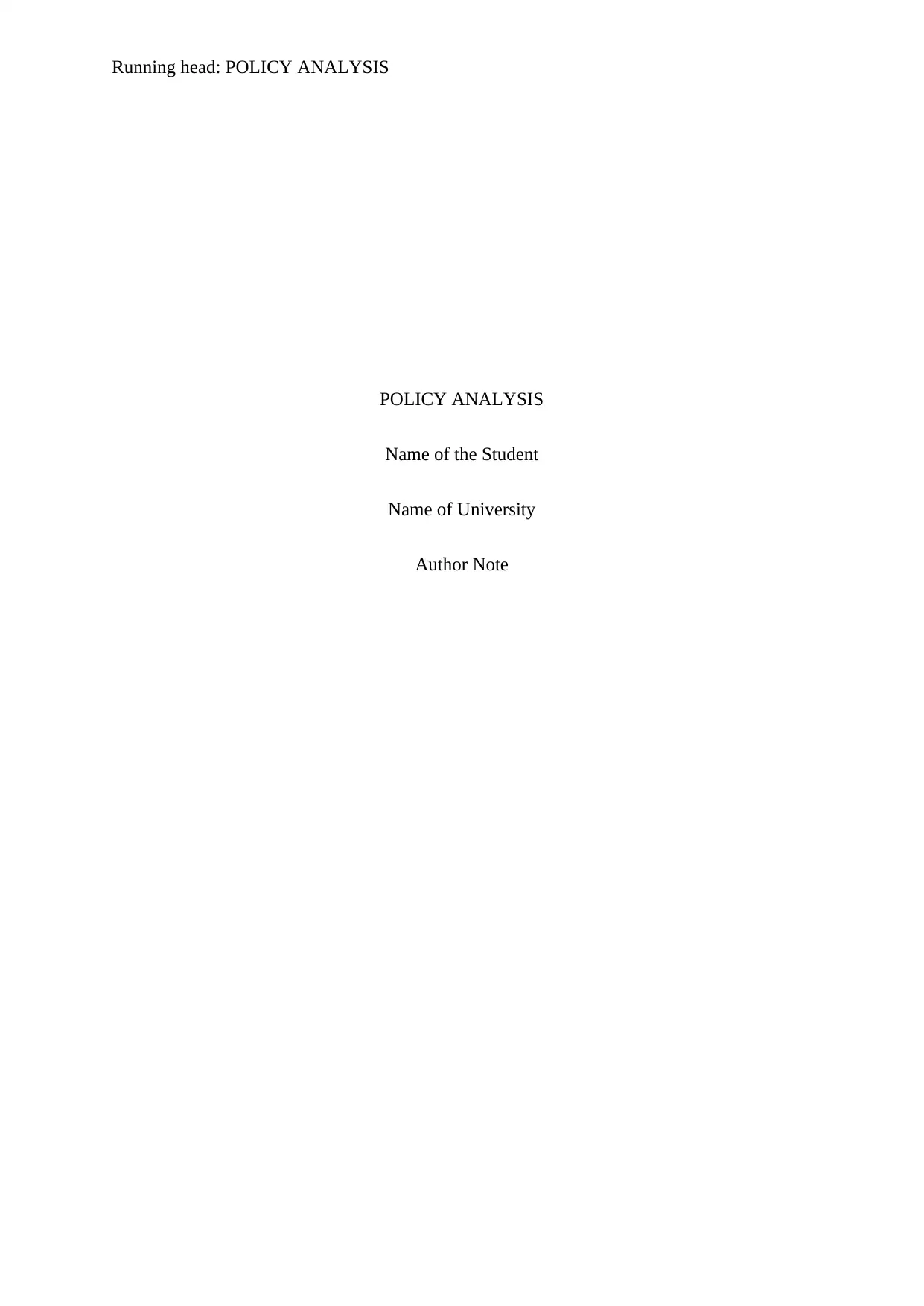
Running head: POLICY ANALYSIS
POLICY ANALYSIS
Name of the Student
Name of University
Author Note
POLICY ANALYSIS
Name of the Student
Name of University
Author Note
Paraphrase This Document
Need a fresh take? Get an instant paraphrase of this document with our AI Paraphraser
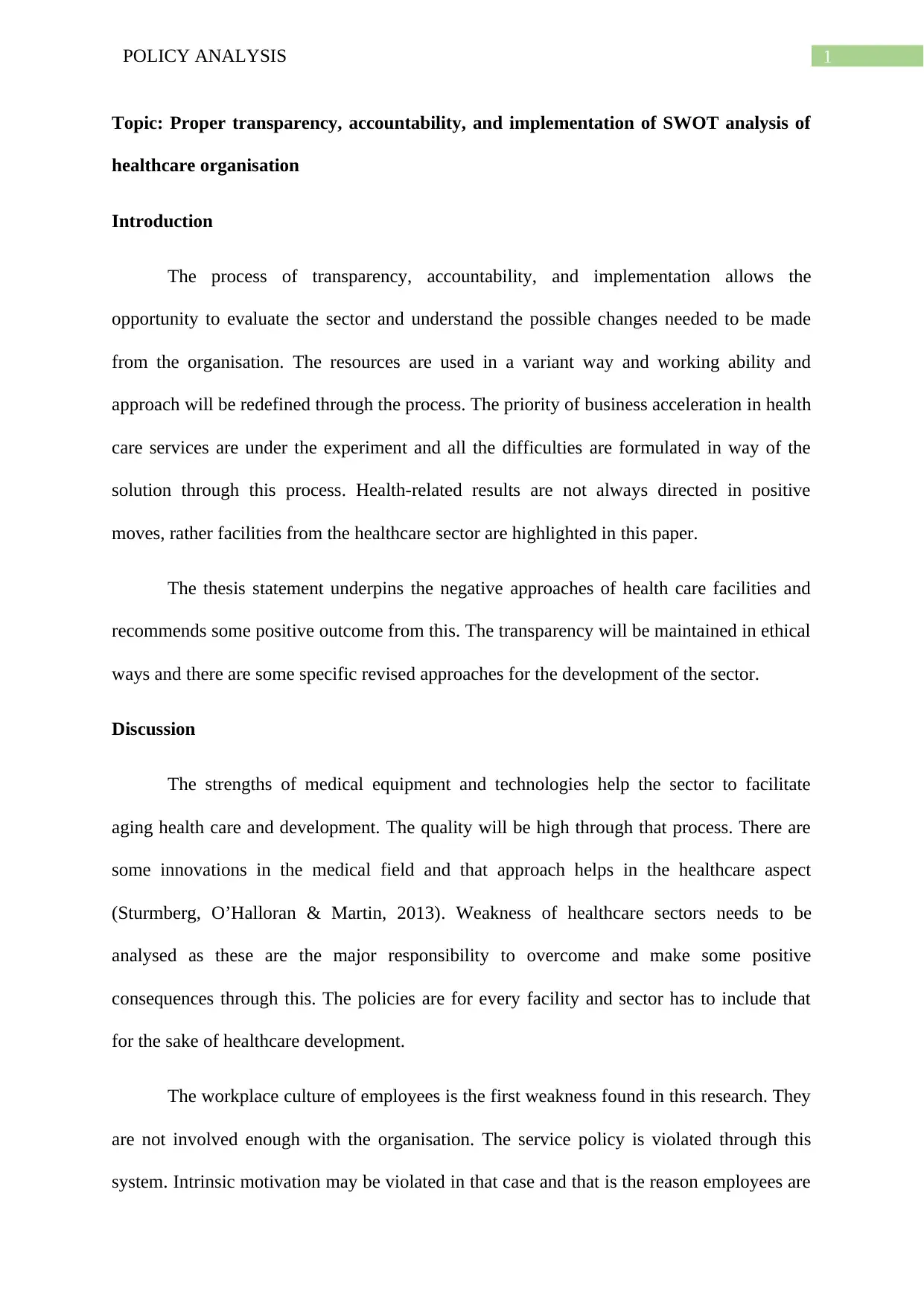
1POLICY ANALYSIS
Topic: Proper transparency, accountability, and implementation of SWOT analysis of
healthcare organisation
Introduction
The process of transparency, accountability, and implementation allows the
opportunity to evaluate the sector and understand the possible changes needed to be made
from the organisation. The resources are used in a variant way and working ability and
approach will be redefined through the process. The priority of business acceleration in health
care services are under the experiment and all the difficulties are formulated in way of the
solution through this process. Health-related results are not always directed in positive
moves, rather facilities from the healthcare sector are highlighted in this paper.
The thesis statement underpins the negative approaches of health care facilities and
recommends some positive outcome from this. The transparency will be maintained in ethical
ways and there are some specific revised approaches for the development of the sector.
Discussion
The strengths of medical equipment and technologies help the sector to facilitate
aging health care and development. The quality will be high through that process. There are
some innovations in the medical field and that approach helps in the healthcare aspect
(Sturmberg, O’Halloran & Martin, 2013). Weakness of healthcare sectors needs to be
analysed as these are the major responsibility to overcome and make some positive
consequences through this. The policies are for every facility and sector has to include that
for the sake of healthcare development.
The workplace culture of employees is the first weakness found in this research. They
are not involved enough with the organisation. The service policy is violated through this
system. Intrinsic motivation may be violated in that case and that is the reason employees are
Topic: Proper transparency, accountability, and implementation of SWOT analysis of
healthcare organisation
Introduction
The process of transparency, accountability, and implementation allows the
opportunity to evaluate the sector and understand the possible changes needed to be made
from the organisation. The resources are used in a variant way and working ability and
approach will be redefined through the process. The priority of business acceleration in health
care services are under the experiment and all the difficulties are formulated in way of the
solution through this process. Health-related results are not always directed in positive
moves, rather facilities from the healthcare sector are highlighted in this paper.
The thesis statement underpins the negative approaches of health care facilities and
recommends some positive outcome from this. The transparency will be maintained in ethical
ways and there are some specific revised approaches for the development of the sector.
Discussion
The strengths of medical equipment and technologies help the sector to facilitate
aging health care and development. The quality will be high through that process. There are
some innovations in the medical field and that approach helps in the healthcare aspect
(Sturmberg, O’Halloran & Martin, 2013). Weakness of healthcare sectors needs to be
analysed as these are the major responsibility to overcome and make some positive
consequences through this. The policies are for every facility and sector has to include that
for the sake of healthcare development.
The workplace culture of employees is the first weakness found in this research. They
are not involved enough with the organisation. The service policy is violated through this
system. Intrinsic motivation may be violated in that case and that is the reason employees are
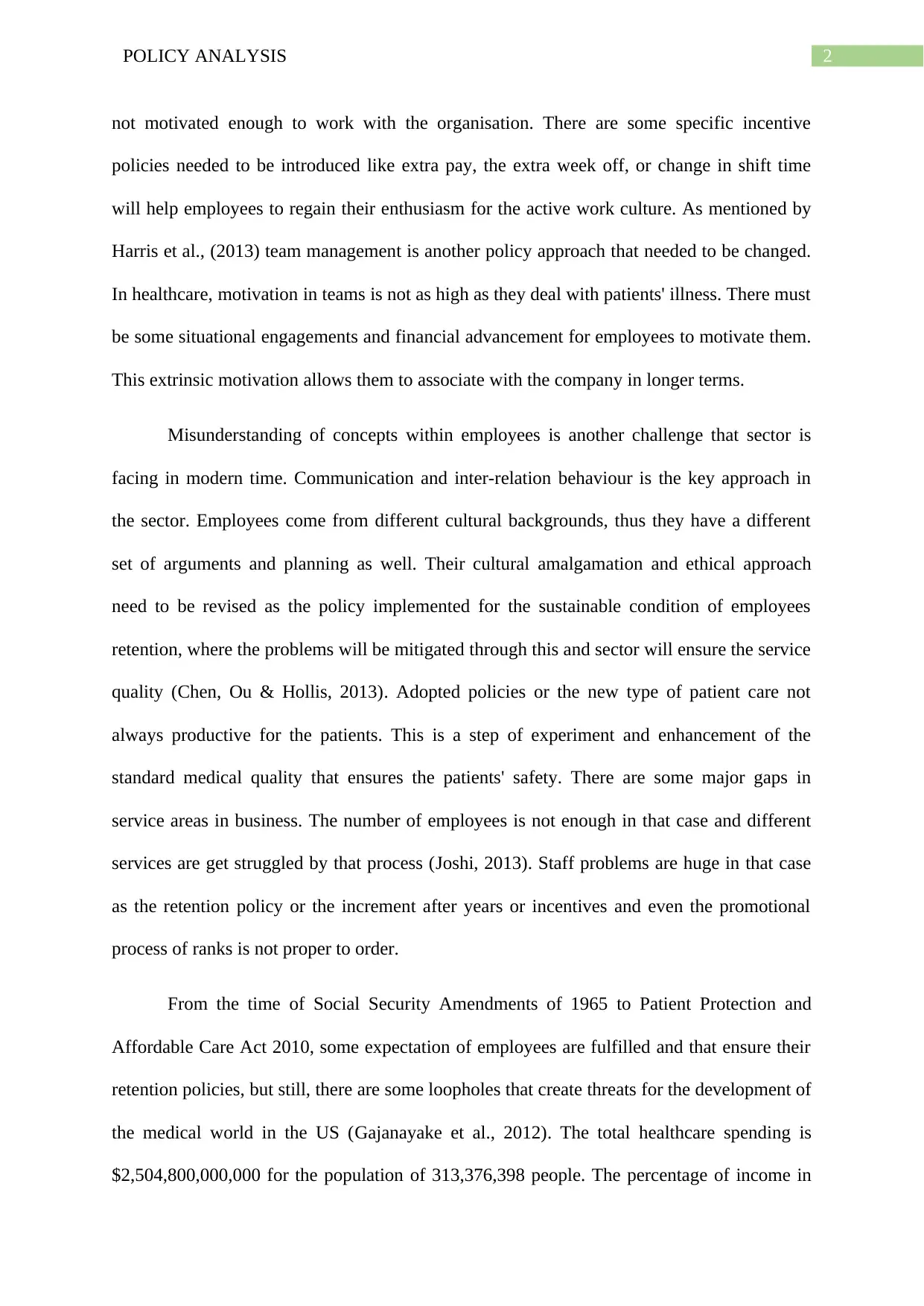
2POLICY ANALYSIS
not motivated enough to work with the organisation. There are some specific incentive
policies needed to be introduced like extra pay, the extra week off, or change in shift time
will help employees to regain their enthusiasm for the active work culture. As mentioned by
Harris et al., (2013) team management is another policy approach that needed to be changed.
In healthcare, motivation in teams is not as high as they deal with patients' illness. There must
be some situational engagements and financial advancement for employees to motivate them.
This extrinsic motivation allows them to associate with the company in longer terms.
Misunderstanding of concepts within employees is another challenge that sector is
facing in modern time. Communication and inter-relation behaviour is the key approach in
the sector. Employees come from different cultural backgrounds, thus they have a different
set of arguments and planning as well. Their cultural amalgamation and ethical approach
need to be revised as the policy implemented for the sustainable condition of employees
retention, where the problems will be mitigated through this and sector will ensure the service
quality (Chen, Ou & Hollis, 2013). Adopted policies or the new type of patient care not
always productive for the patients. This is a step of experiment and enhancement of the
standard medical quality that ensures the patients' safety. There are some major gaps in
service areas in business. The number of employees is not enough in that case and different
services are get struggled by that process (Joshi, 2013). Staff problems are huge in that case
as the retention policy or the increment after years or incentives and even the promotional
process of ranks is not proper to order.
From the time of Social Security Amendments of 1965 to Patient Protection and
Affordable Care Act 2010, some expectation of employees are fulfilled and that ensure their
retention policies, but still, there are some loopholes that create threats for the development of
the medical world in the US (Gajanayake et al., 2012). The total healthcare spending is
$2,504,800,000,000 for the population of 313,376,398 people. The percentage of income in
not motivated enough to work with the organisation. There are some specific incentive
policies needed to be introduced like extra pay, the extra week off, or change in shift time
will help employees to regain their enthusiasm for the active work culture. As mentioned by
Harris et al., (2013) team management is another policy approach that needed to be changed.
In healthcare, motivation in teams is not as high as they deal with patients' illness. There must
be some situational engagements and financial advancement for employees to motivate them.
This extrinsic motivation allows them to associate with the company in longer terms.
Misunderstanding of concepts within employees is another challenge that sector is
facing in modern time. Communication and inter-relation behaviour is the key approach in
the sector. Employees come from different cultural backgrounds, thus they have a different
set of arguments and planning as well. Their cultural amalgamation and ethical approach
need to be revised as the policy implemented for the sustainable condition of employees
retention, where the problems will be mitigated through this and sector will ensure the service
quality (Chen, Ou & Hollis, 2013). Adopted policies or the new type of patient care not
always productive for the patients. This is a step of experiment and enhancement of the
standard medical quality that ensures the patients' safety. There are some major gaps in
service areas in business. The number of employees is not enough in that case and different
services are get struggled by that process (Joshi, 2013). Staff problems are huge in that case
as the retention policy or the increment after years or incentives and even the promotional
process of ranks is not proper to order.
From the time of Social Security Amendments of 1965 to Patient Protection and
Affordable Care Act 2010, some expectation of employees are fulfilled and that ensure their
retention policies, but still, there are some loopholes that create threats for the development of
the medical world in the US (Gajanayake et al., 2012). The total healthcare spending is
$2,504,800,000,000 for the population of 313,376,398 people. The percentage of income in
⊘ This is a preview!⊘
Do you want full access?
Subscribe today to unlock all pages.

Trusted by 1+ million students worldwide
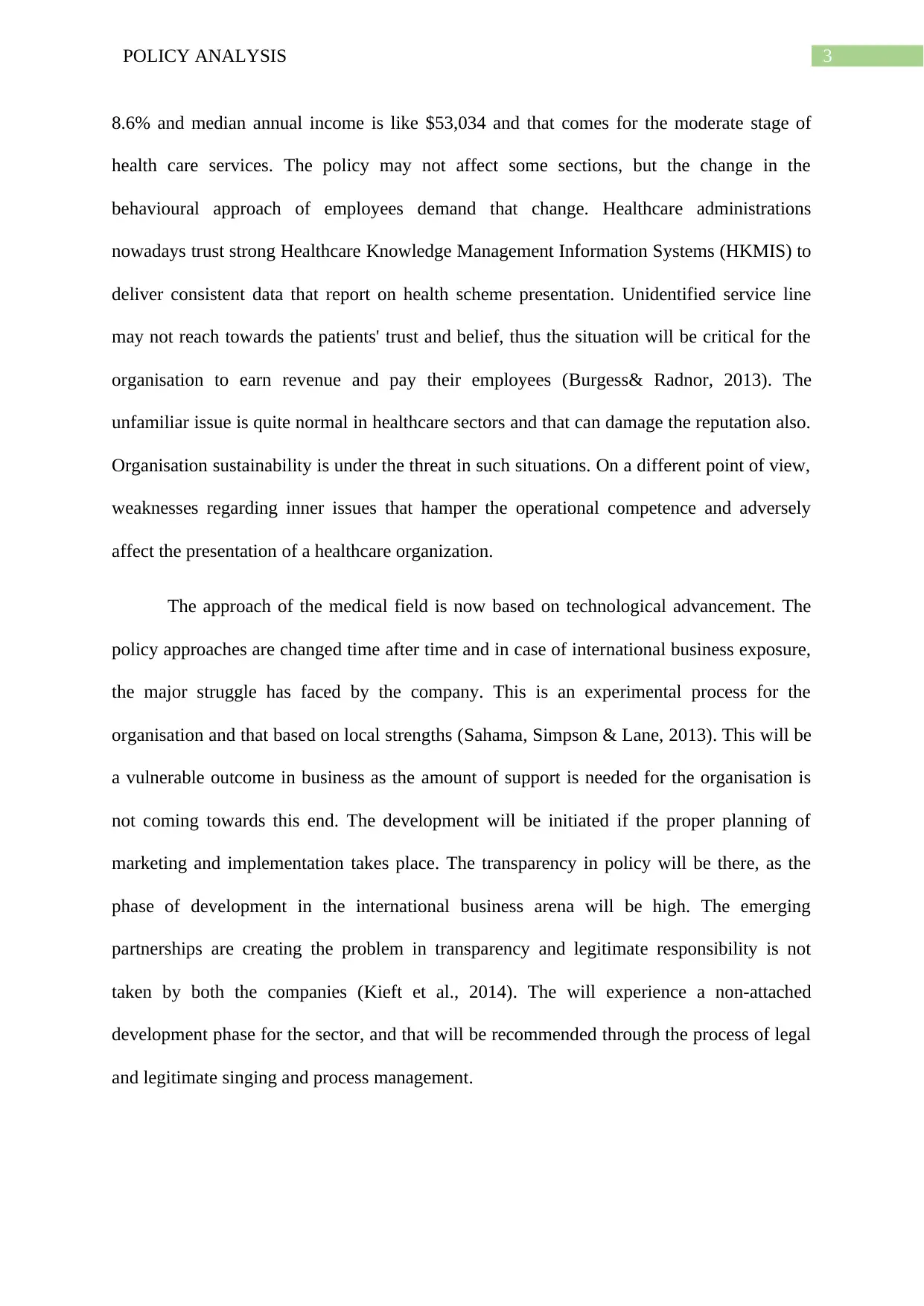
3POLICY ANALYSIS
8.6% and median annual income is like $53,034 and that comes for the moderate stage of
health care services. The policy may not affect some sections, but the change in the
behavioural approach of employees demand that change. Healthcare administrations
nowadays trust strong Healthcare Knowledge Management Information Systems (HKMIS) to
deliver consistent data that report on health scheme presentation. Unidentified service line
may not reach towards the patients' trust and belief, thus the situation will be critical for the
organisation to earn revenue and pay their employees (Burgess& Radnor, 2013). The
unfamiliar issue is quite normal in healthcare sectors and that can damage the reputation also.
Organisation sustainability is under the threat in such situations. On a different point of view,
weaknesses regarding inner issues that hamper the operational competence and adversely
affect the presentation of a healthcare organization.
The approach of the medical field is now based on technological advancement. The
policy approaches are changed time after time and in case of international business exposure,
the major struggle has faced by the company. This is an experimental process for the
organisation and that based on local strengths (Sahama, Simpson & Lane, 2013). This will be
a vulnerable outcome in business as the amount of support is needed for the organisation is
not coming towards this end. The development will be initiated if the proper planning of
marketing and implementation takes place. The transparency in policy will be there, as the
phase of development in the international business arena will be high. The emerging
partnerships are creating the problem in transparency and legitimate responsibility is not
taken by both the companies (Kieft et al., 2014). The will experience a non-attached
development phase for the sector, and that will be recommended through the process of legal
and legitimate singing and process management.
8.6% and median annual income is like $53,034 and that comes for the moderate stage of
health care services. The policy may not affect some sections, but the change in the
behavioural approach of employees demand that change. Healthcare administrations
nowadays trust strong Healthcare Knowledge Management Information Systems (HKMIS) to
deliver consistent data that report on health scheme presentation. Unidentified service line
may not reach towards the patients' trust and belief, thus the situation will be critical for the
organisation to earn revenue and pay their employees (Burgess& Radnor, 2013). The
unfamiliar issue is quite normal in healthcare sectors and that can damage the reputation also.
Organisation sustainability is under the threat in such situations. On a different point of view,
weaknesses regarding inner issues that hamper the operational competence and adversely
affect the presentation of a healthcare organization.
The approach of the medical field is now based on technological advancement. The
policy approaches are changed time after time and in case of international business exposure,
the major struggle has faced by the company. This is an experimental process for the
organisation and that based on local strengths (Sahama, Simpson & Lane, 2013). This will be
a vulnerable outcome in business as the amount of support is needed for the organisation is
not coming towards this end. The development will be initiated if the proper planning of
marketing and implementation takes place. The transparency in policy will be there, as the
phase of development in the international business arena will be high. The emerging
partnerships are creating the problem in transparency and legitimate responsibility is not
taken by both the companies (Kieft et al., 2014). The will experience a non-attached
development phase for the sector, and that will be recommended through the process of legal
and legitimate singing and process management.
Paraphrase This Document
Need a fresh take? Get an instant paraphrase of this document with our AI Paraphraser
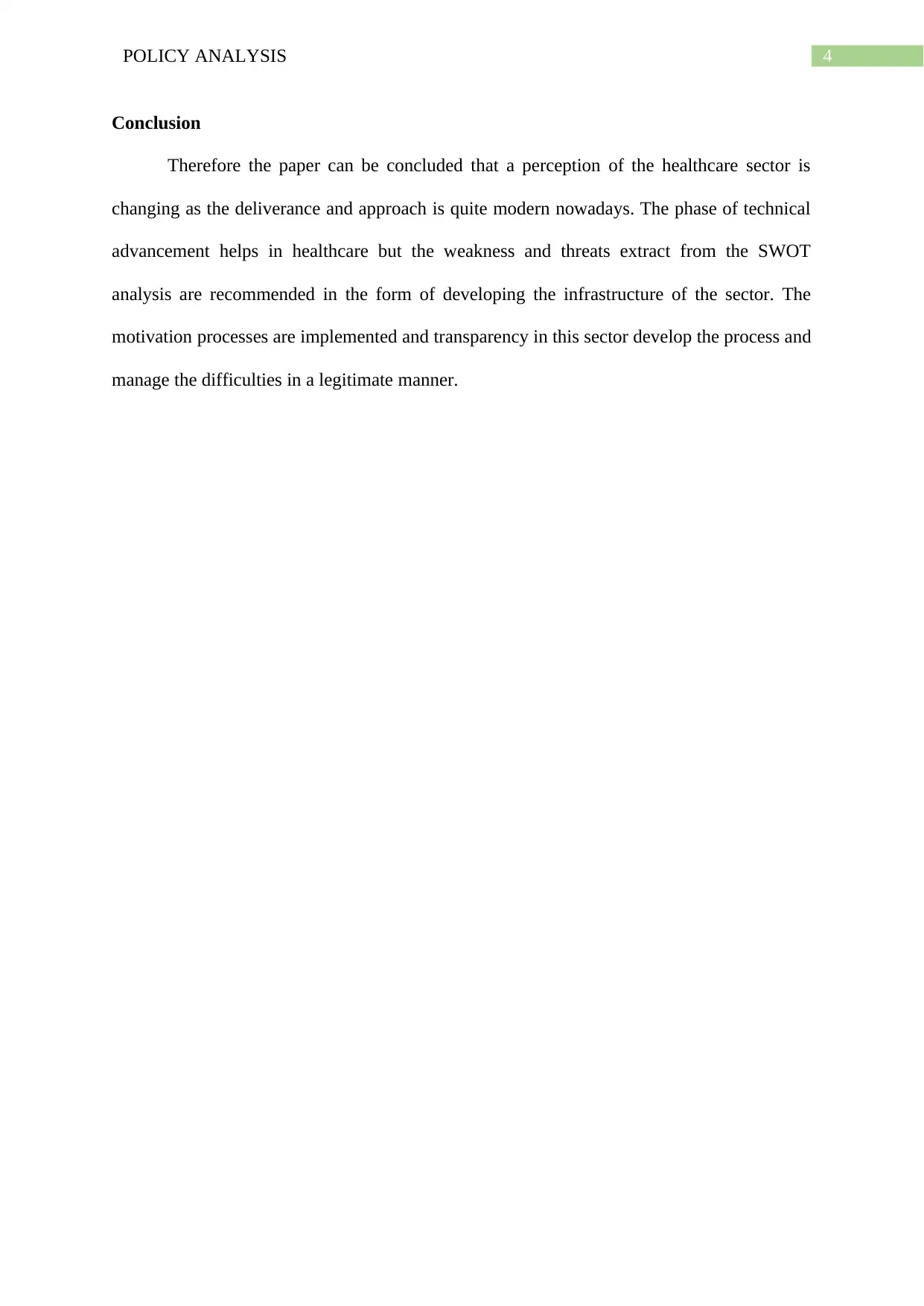
4POLICY ANALYSIS
Conclusion
Therefore the paper can be concluded that a perception of the healthcare sector is
changing as the deliverance and approach is quite modern nowadays. The phase of technical
advancement helps in healthcare but the weakness and threats extract from the SWOT
analysis are recommended in the form of developing the infrastructure of the sector. The
motivation processes are implemented and transparency in this sector develop the process and
manage the difficulties in a legitimate manner.
Conclusion
Therefore the paper can be concluded that a perception of the healthcare sector is
changing as the deliverance and approach is quite modern nowadays. The phase of technical
advancement helps in healthcare but the weakness and threats extract from the SWOT
analysis are recommended in the form of developing the infrastructure of the sector. The
motivation processes are implemented and transparency in this sector develop the process and
manage the difficulties in a legitimate manner.
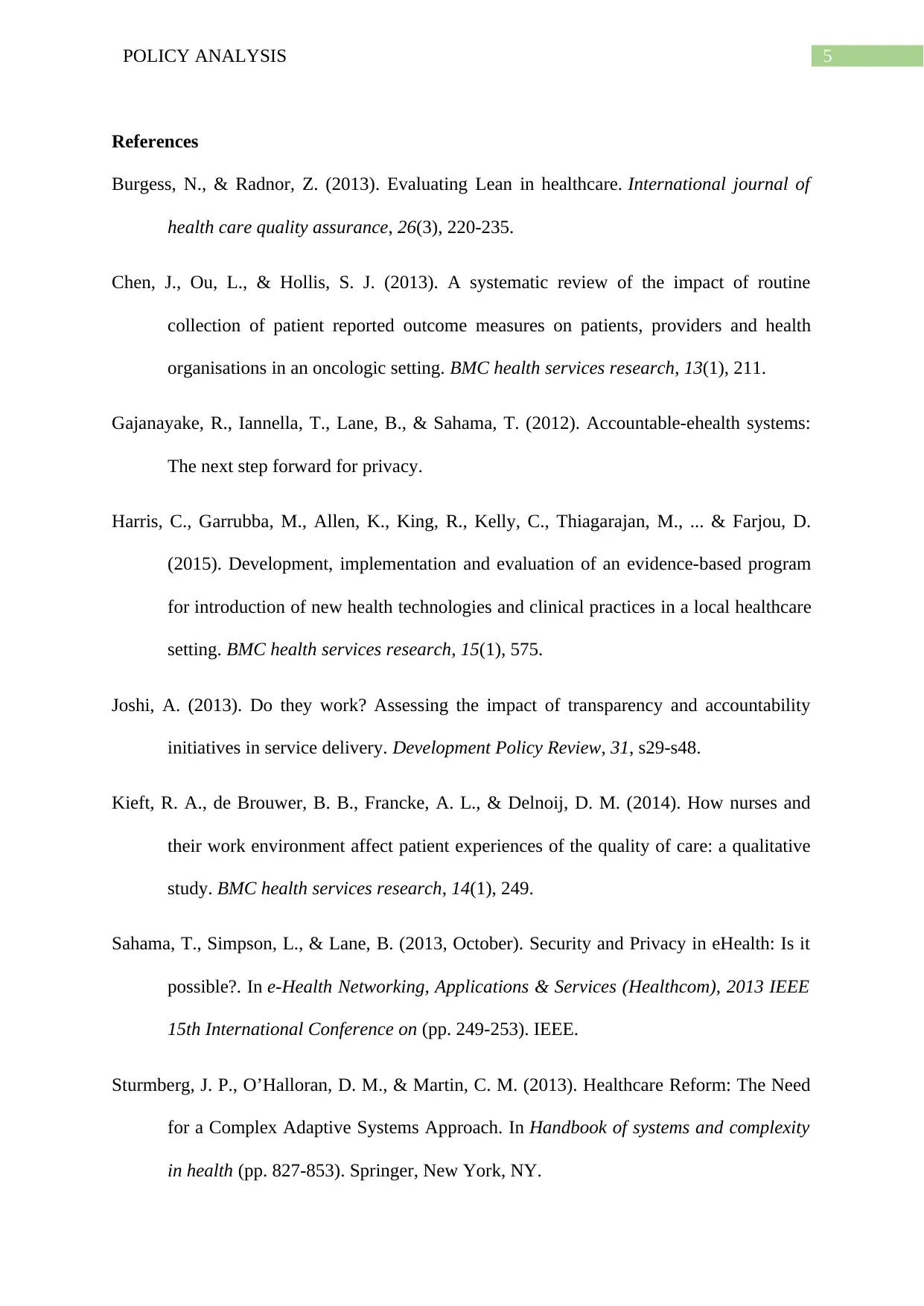
5POLICY ANALYSIS
References
Burgess, N., & Radnor, Z. (2013). Evaluating Lean in healthcare. International journal of
health care quality assurance, 26(3), 220-235.
Chen, J., Ou, L., & Hollis, S. J. (2013). A systematic review of the impact of routine
collection of patient reported outcome measures on patients, providers and health
organisations in an oncologic setting. BMC health services research, 13(1), 211.
Gajanayake, R., Iannella, T., Lane, B., & Sahama, T. (2012). Accountable-ehealth systems:
The next step forward for privacy.
Harris, C., Garrubba, M., Allen, K., King, R., Kelly, C., Thiagarajan, M., ... & Farjou, D.
(2015). Development, implementation and evaluation of an evidence-based program
for introduction of new health technologies and clinical practices in a local healthcare
setting. BMC health services research, 15(1), 575.
Joshi, A. (2013). Do they work? Assessing the impact of transparency and accountability
initiatives in service delivery. Development Policy Review, 31, s29-s48.
Kieft, R. A., de Brouwer, B. B., Francke, A. L., & Delnoij, D. M. (2014). How nurses and
their work environment affect patient experiences of the quality of care: a qualitative
study. BMC health services research, 14(1), 249.
Sahama, T., Simpson, L., & Lane, B. (2013, October). Security and Privacy in eHealth: Is it
possible?. In e-Health Networking, Applications & Services (Healthcom), 2013 IEEE
15th International Conference on (pp. 249-253). IEEE.
Sturmberg, J. P., O’Halloran, D. M., & Martin, C. M. (2013). Healthcare Reform: The Need
for a Complex Adaptive Systems Approach. In Handbook of systems and complexity
in health (pp. 827-853). Springer, New York, NY.
References
Burgess, N., & Radnor, Z. (2013). Evaluating Lean in healthcare. International journal of
health care quality assurance, 26(3), 220-235.
Chen, J., Ou, L., & Hollis, S. J. (2013). A systematic review of the impact of routine
collection of patient reported outcome measures on patients, providers and health
organisations in an oncologic setting. BMC health services research, 13(1), 211.
Gajanayake, R., Iannella, T., Lane, B., & Sahama, T. (2012). Accountable-ehealth systems:
The next step forward for privacy.
Harris, C., Garrubba, M., Allen, K., King, R., Kelly, C., Thiagarajan, M., ... & Farjou, D.
(2015). Development, implementation and evaluation of an evidence-based program
for introduction of new health technologies and clinical practices in a local healthcare
setting. BMC health services research, 15(1), 575.
Joshi, A. (2013). Do they work? Assessing the impact of transparency and accountability
initiatives in service delivery. Development Policy Review, 31, s29-s48.
Kieft, R. A., de Brouwer, B. B., Francke, A. L., & Delnoij, D. M. (2014). How nurses and
their work environment affect patient experiences of the quality of care: a qualitative
study. BMC health services research, 14(1), 249.
Sahama, T., Simpson, L., & Lane, B. (2013, October). Security and Privacy in eHealth: Is it
possible?. In e-Health Networking, Applications & Services (Healthcom), 2013 IEEE
15th International Conference on (pp. 249-253). IEEE.
Sturmberg, J. P., O’Halloran, D. M., & Martin, C. M. (2013). Healthcare Reform: The Need
for a Complex Adaptive Systems Approach. In Handbook of systems and complexity
in health (pp. 827-853). Springer, New York, NY.
⊘ This is a preview!⊘
Do you want full access?
Subscribe today to unlock all pages.

Trusted by 1+ million students worldwide
1 out of 6
Related Documents
Your All-in-One AI-Powered Toolkit for Academic Success.
+13062052269
info@desklib.com
Available 24*7 on WhatsApp / Email
![[object Object]](/_next/static/media/star-bottom.7253800d.svg)
Unlock your academic potential
Copyright © 2020–2025 A2Z Services. All Rights Reserved. Developed and managed by ZUCOL.





